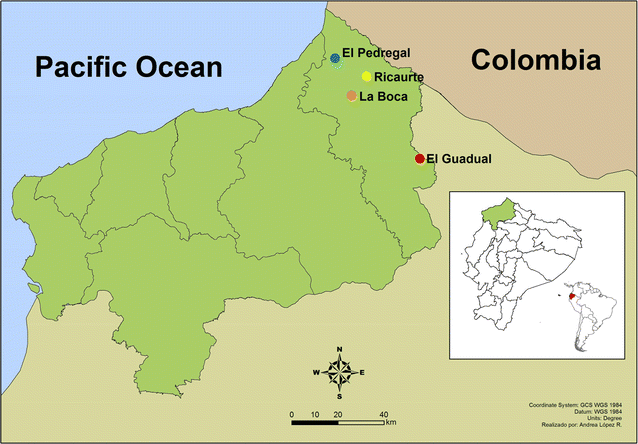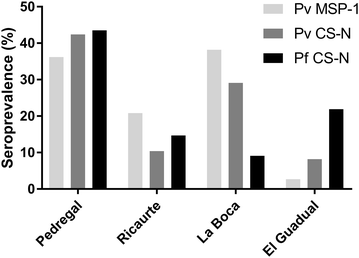Malaria epidemiology in low-endemicity areas of the northern coast of Ecuador: high prevalence of asymptomatic infections
- PMID: 28747199
- PMCID: PMC5530496
- DOI: 10.1186/s12936-017-1947-0
Malaria epidemiology in low-endemicity areas of the northern coast of Ecuador: high prevalence of asymptomatic infections
Abstract
Background: The recent scale-up in malaria control measures in Latin America has resulted in a significant decrease in the number of reported cases in several countries including Ecuador, where it presented a low malaria incidence in recent years (558 reported cases in 2015) with occasional outbreaks of both Plasmodium falciparum and Plasmodium vivax in the coastal and Amazonian regions. This success in malaria control in recent years has led Ecuador to transition its malaria policy from control to elimination.
Results: This study evaluated the general knowledge, attitude and practices (KAP) about malaria, as well as its prevalence in four communities of an endemic area in northwest Ecuador. A total of 258 interviews to assess KAP in the community indicated that most people in the study area have a basic knowledge about the disease but did not use to contribute to its control. Six hundred and forty-eight blood samples were collected and analysed by thick blood smear and real-time PCR. In addition, the distribution of the infections was mapped in the study communities. Although, no parasites were found by microscopy, by PCR the total malaria prevalence was 7.5% (6.9% P. vivax and 0.6% P. falciparum), much higher than expected and comparable to that reported in endemic areas of neighbouring countries with higher malaria transmission. Serology using ELISA and immunofluorescence indicated 27% respondents for P. vivax and 22% respondents for P. falciparum.
Conclusions: Results suggest that despite a great malaria reduction in Ecuador, transition from control to elimination would demand further improvement in malaria diagnostics, including active case detection to identify and treat parasite asymptomatic carriers, as well as community participation in its elimination.
Keywords: Asymptomatic malaria; Ecuador; Elimination; Knowledge attitude and practices.
Figures





References
-
- SIVE-ALERTA. Gaceta epidemiológica Ecuador, semana 52, 2016. 2017.
-
- WHO. World malaria report. World Health Organization, Geneva, Switzerland, 2016.
-
- PAHO. Report on the situation of malaria in the Americas 2012. Panamerican Health Organization. 2013.
-
- WHO. Eliminating malaria. World Health Organization, Geneva, Switzerland, 2016.
Publication types
MeSH terms
Grants and funding
LinkOut - more resources
Full Text Sources
Other Literature Sources

